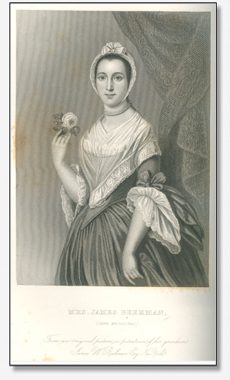
Rufus W. Griswold, The Republican Court, or, American Society in the Days of Washington. New and rev. ed. (New York, 1856), plate opposite 155. First ed., 1855.
| JANE KETELTAS BEEKMAN (1734-1817)
Born and raised in New York, Jane Keteltas became an important member of the city’s social elite with her marriage to James Beekman in October 1752. Beekman (1732-1807), also a native New Yorker, came from a prominent family that had arrived from Holland in the mid-17th century. In addition to being a wealthy merchant, he was renowned for participating in the “General Committee of One Hundred,” chosen on May 1, 1775, which was formed to take charge of the city until a Provincial Congress could be assembled. Later he would also help to draft the Constitution for the state of New York.[1] James and Jane Beekman are perhaps most remembered for their elegant country house, Mount Pleasant, located on the east side of Manhattan Island, about four miles north of their town home on Hanover Square. Like many patriot families, the Beekmans left New York during the Revolutionary War’s nearly seven-year term of British occupation, and in their absence, Mount Pleasant was used to house military officers. General George Washington and his officers, on the occasion of their “triumphal entry into New York,” stopped at Beekman house to enjoy a glass of lemonade (made from Jane Beekman’s greenhouse-grown lemons)[2] and to celebrate America’s freedom in the very house where the British officers had plotted their campaigns not long before.[3] Jane Beekman presided over the education of the couple’s ten, possibly twelve, children. According to John Austin Stevens, she was a “very clever and accomplished woman” who was not only a teacher to her children but also served as bookkeeper for her husband’s business, and “on one occasion, when a ship arrived in her husband’s absence at Philadelphia, she had transacted all the custom’s business perfectly before his return.”[4] At their homes in New York, the Beekmans entertained prestigious guests such as George and Martha Washington, and often attended balls and social gatherings at other elite New Yorkers’ residences. The Beekmans were present at the first Inauguration Ball in New York, an event to recognize Washington’s presidency—and an event where, according to an anonymous speaker quoted in Rufus Griswold’s The Republican Court, “The collection of ladies was numerous and brilliant, and they were dressed with consummate taste and elegance.”[5] Griswold goes on to list Mrs. Beekman among “the most distinguished women at the ball.”[6] When Mount Pleasant was demolished in 1874, the carved and paneled rococo chimney breast from drawing room was presented to the New-York Historical Society; it was followed by other architectural fragments, textiles, family portraits, and decorative arts owned by the Beekmans. Also given was James and Jane Beekman’s splendid coach, which was purchased in 1771 and is reputed to have been used to carry George Washington to his inauguration.[7] These and other such relics provide valuable evidence of the material culture surrounding Jane Keteltas Beekman and her cohort during the Republican age. Written by Annie Turner.____________________ [1] John Austin Stevens, Colonial Records of the New York Chamber of Commerce: 1768-1784 (1867; repr., New York: Ayer Publishing, 1971), 122. [2] Ibid., 122-23. [3] Edward F. de Lancey, Memoir of James William Beekman (New York: Saint Nicholas Society of the City of New York, 1877), 12-13; William B. Aitken, Distinguished Families in America (New York: G.P. Putnam’s Sons, 1912), 120. [4] Stevens, Colonial Records, 122. [5] As quoted in Rufus W. Griswold, The Republican Court, or, American Society in the Days of Washington (New York: D. Appleton and Company, 1867), 155. [6] Ibid., 155-56. [7] Aitken, Distinguished Families, 120. |

